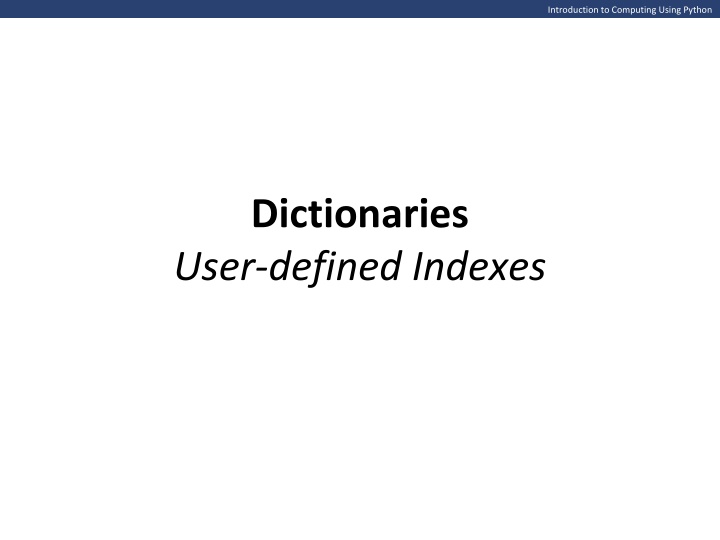
Python Dictionaries: User-defined Indexes and Employee Records
Learn how to use Python dictionaries with user-defined indexes to store and access employee records efficiently. Explore the concept of key-value pairs in dictionaries and understand how they can be leveraged as indexes for data retrieval.
Download Presentation

Please find below an Image/Link to download the presentation.
The content on the website is provided AS IS for your information and personal use only. It may not be sold, licensed, or shared on other websites without obtaining consent from the author. If you encounter any issues during the download, it is possible that the publisher has removed the file from their server.
You are allowed to download the files provided on this website for personal or commercial use, subject to the condition that they are used lawfully. All files are the property of their respective owners.
The content on the website is provided AS IS for your information and personal use only. It may not be sold, licensed, or shared on other websites without obtaining consent from the author.
E N D
Presentation Transcript
Introduction to Computing Using Python Dictionaries User-defined Indexes
Introduction to Computing Using Python User-defined indexes and dictionaries >>> employee[987654321] ['Yu', 'Tsun'] >>> employee[864209753] ['Anna', 'Karenina'] >>> employee[100010010] ['Hans', 'Castorp'] Goal: a container of employee records indexed by employee SS# Problems: the range of SS#s is huge SS#s are not really integers Solution: the dictionary class dict >>> employee = { >>> >>> employee['987-65-4321'] ['Yu', 'Tsun'] >>> employee['864-20-9753'] ['Anna', 'Karenina'] >>> employee = { key value '864-20-9753': ['Anna', 'Karenina'], '987-65-4321': ['Yu', 'Tsun'], '100-01-0010': ['Hans', 'Castorp']} '100-01-0010': ['Hans', 'Castorp']} '864-20-9753': ['Anna', 'Karenina'], '987-65-4321': ['Yu', 'Tsun'], '864-20-9753' ['Anna', 'Karenina'] '987-65-4321' ['Yu', 'Tsun'] '100-01-0010' ['Hans', 'Castorp'] A dictionary contains (key, value) pairs A key can be used as an index to access the corresponding value
Introduction to Computing Using Python Properties of dictionaries >>> employee = { >>> employee {'100-01-0010': ['Hans', 'Castorp'], '864-20- 9753': ['Anna', 'Karenina'], '987-65-4321': ['Yu', 'Tsun']} >>> employee['123-45-6789'] = 'Holden Cafield' >>> employee {'100-01-0010': ['Hans', 'Castorp'], '864-20- 9753': ['Anna', 'Karenina'], '987-65-4321': ['Yu', 'Tsun'], '123-45-6789': 'Holden Cafield'} >>> >>> employee['123-45-6789'] = 'Holden Caulfield' >>> employee {'100-01-0010': ['Hans', 'Castorp'], '864-20- 9753': ['Anna', 'Karenina'], '987-65-4321': ['Yu', 'Tsun'], '123-45-6789': 'Holden Caulfield } File "<pyshell#2>", line 1, in <module> employee = {[1,2]:1, [2,3]:3} TypeError: unhashable type: 'list' >>> employee = { >>> employee {'100-01-0010': ['Hans', 'Castorp'], '864-20- 9753': ['Anna', 'Karenina'], '987-65-4321': ['Yu', 'Tsun']} >>> >>> employee = { '864-20-9753': ['Anna', 'Karenina'], '987-65-4321': ['Yu', 'Tsun'], '100-01-0010': ['Hans', 'Castorp']} '100-01-0010': ['Hans', 'Castorp']} >>> employee {'100-01-0010': ['Hans', 'Castorp'], '864-20- 9753': ['Anna', 'Karenina'], '987-65-4321': ['Yu', 'Tsun']} >>> employee['123-45-6789'] = 'Holden Cafield' >>> employee {'100-01-0010': ['Hans', 'Castorp'], '864-20- 9753': ['Anna', 'Karenina'], '987-65-4321': ['Yu', 'Tsun'], '123-45-6789': 'Holden Cafield'} '864-20-9753': ['Anna', 'Karenina'], '987-65-4321': ['Yu', 'Tsun'], '987-65-4321': ['Yu', 'Tsun'], '100-01-0010': ['Hans', 'Castorp']} '864-20-9753': ['Anna', 'Karenina'], Dictionaries are not ordered Dictionaries are mutable Dictionaries are mutable Dictionaries are mutable new (key,value) pairs can be added can be added the value corresponding to a key can be modified new (key,value) pairs The empty dictionary is {} >>> employee = {[1,2]:1, [2,3]:3} Traceback (most recent call last): Dictionary keys must be immutable
Introduction to Computing Using Python Dictionary operators Class dict supports some of the same operators as class list >>> days = {'Mo':1, 'Tu':2, 'W':3} >>> days['Mo'] 1 >>> days['Th'] = 5 >>> days {'Mo': 1, 'Tu': 2, 'Th': 5, 'W': 3} >>> days['Th'] = 4 >>> days {'Mo': 1, 'Tu': 2, 'Th': 4, 'W': 3} >>> 'Fr' in days False >>> len(days) 4 Class dict does not support all the operators that class list supports + and * for example
Introduction to Computing Using Python Dictionary methods >>> days {'Mo': 1, 'Tu': 2, 'Th': 4, 'W': 3} >>> days.pop('Tu') 2 >>> days {'Mo': 1, 'Th': 4, 'W': 3} >>> days2 = {'Tu':2, 'Fr':5} >>> days.update(days2) >>> days {'Fr': 5, 'W': 3, 'Th': 4, 'Mo': 1, 'Tu': 2} >>> days.items() dict_items([('Fr', 5), ('W', 3), ('Th', 4), ('Mo', 1), ('Tu', 2)]) >>> days.keys() dict_keys(['Fr', 'W', 'Th', 'Mo', 'Tu']) >>> >>> vals = days.values() >>> vals dict_values([5, 3, 4, 1, 2]) >>> for val in vals: print(val, end=' ') >>> days {'Mo': 1, 'Tu': 2, 'Th': 4, 'W': 3} >>> days.pop('Tu') 2 >>> days {'Mo': 1, 'Th': 4, 'W': 3} >>> days2 = {'Tu':2, 'Fr':5} >>> days.update(days2) >>> days {'Fr': 5, 'W': 3, 'Th': 4, 'Mo': 1, 'Tu': 2} >>> days.items() dict_items([('Fr', 5), ('W', 3), ('Th', 4), ('Mo', 1), ('Tu', 2)]) >>> days.keys() dict_keys(['Fr', 'W', 'Th', 'Mo', 'Tu']) >>> >>> vals = days.values() >>> vals dict_values([5, 3, 4, 1, 2]) >>> Operation Explanation d.items() Returns a view of the (key, value) pairs in d d.keys() Returns a view of the keys of d d.pop(key) Removes the (key, value) pair with key key from d and returns the value d.update(d2) Adds the (key, value) pairs of dictionary d2 to d d.values() Returns a view of the values of d The containers returned by d.items(), d.keys(), and d.values() (called views) can be iterated over 5 3 4 1 2 >>>
Introduction to Computing Using Python Dictionary vs. multi-way if statement Uses of a dictionary: container with custom indexes container with custom indexes alternative to the multi-way if statement Uses of a dictionary: def complete(abbreviation): 'returns day of the week corresponding to abbreviation' if abbreviation == 'Mo': return 'Monday' elif abbreviation == 'Tu': return 'Tuesday' elif ...... else: # abbreviation must be Su return 'Sunday' def complete(abbreviation): 'returns day of the week corresponding to abbreviation' days = {'Mo': 'Monday', 'Tu':'Tuesday', 'We': 'Wednesday', 'Th': 'Thursday', 'Fr': 'Friday', 'Sa': 'Saturday', 'Su':'Sunday'} return days[abbreviation]
Introduction to Computing Using Python Dictionary as a container of counters Uses of a dictionary: container with custom indexes alternative to the multi-way if statement container of counters Problem: computing the number of occurrences of items in a list >>> grades = [95, 96, 100, 85, 95, 90, 95, 100, 100] >>> frequency(grades) {96: 1, 90: 1, 100: 3, 85: 1, 95: 3} >>> Solution: Iterate through the list and, for each grade, increment the counter corresponding to the grade. Problems: impossible to create counters before seeing what s in the list how to store grade counters so a counter is accessible using the corresponding grade Solution: a dictionary mapping a grade (the key) to its counter (the value)
Introduction to Computing Using Python Dictionary as a container of counters Problem: computing the number of occurrences of items in a list >>> grades = [95, 96, 100, 85, 95, 90, 95, 100, 100] 95 95 95 96 100 85 90 counters 1 2 3 1 1 1 1 def frequency(itemList): def frequency(itemList): 'returns frequency of items in itemList' 'returns frequency of items in itemList' counters = {} counters = {} for item in itemList: if item in counters: # increment item counter counters[item] += 1 else: # create item counter counters[item] = 1 return counters
Introduction to Computing Using Python Exercise Implement function wordcount() that takes as input a text as a string and prints the frequency of each word in the text; assume there is no punctuation in the text. def wordCount(text): 'prints frequency of each word in text' >>> text = 'all animals are equal but some animals are more equal than other' >>> wordCount(text) all appears 1 time. animals appears 2 times. some appears 1 time. equal appears 2 times. but appears 1 time. other appears 1 time. wordList = text.split() # split text into list of words def numChars(filename): 'returns the number of characters in file filename' counters ={} # dictionary of counters for word in wordList: if word in counters: # counter for word exists counters[word] += 1 else: # counter for word doesn't exist counters[word] = 1 are appears 2 times. than appears 1 time. more appears 1 time. >>> infile = open(filename, 'r') content = infile.read() infile.close() return len(content) for word in counters: # print word counts if counters[word] == 1: print('{:8} appears {} time.'.format(word, counters[word])) else: print('{:8} appears {} times.'.format(word, counters[word]))
Introduction to Computing Using Python Exercise Implement function lookup() that implements a phone book lookup application. Your function takes, as input, a dictionary representing a phone book, mappingtuples (containing the first and last name) to strings (containing phone numbers) >>> lookup(phonebook) Enter the first name: Anna Enter the last name: Karenina (123)456-78-90 Enter the first name: >>> phonebook = { ('Anna','Karenina'):'(123)456-78-90', ('Yu', 'Tsun'):'(901)234-56-78', ('Hans', 'Castorp'):'(321)908-76-54'} def lookup(phonebook): '''implements interactive phone book service using the input phonebook dictionary''' while True: first = input('Enter the first name: ') last = input('Enter the last name: ') person = (first, last) # construct the key if person in phonebook: # if key is in dictionary print(phonebook[person]) # print value else: # if key not in dictionary print('The name you entered is not known.')
Dict Comprehensions in Python By Dr. Ziad Al-Sharif
Remember Comprehensions Remember Comprehensions Syntax expr for item in iterable if condition expr1 if condition else expr2 for item in iterable >>> grades = [95, 96, 100, 85, 95, 90, 95, 100, 100] >>> L = [ x+1 for x in grades if x<100] >>> L [96, 97, 86, 96, 91, 96] >>> >>> L = [ x+1 if x<100 else x for x in grades] >>> L [96, 97, 100, 86, 96, 91, 96, 100, 100] >>>
Remember Comprehensions Remember Comprehensions Syntax expr1 if cond1 else expr2 for item in iterable if cond2 >>> grades = [95, 96, 100, 85, 95, 90, 95, 100, 100] >>> L = [ x+2 if x<90 else x+1 for x in grades if x<100] >>> L [96, 97, 87, 96, 91, 96] >>>
Dict Comprehensions Semantics >>> d = dict() >>>for i in range(4): d[i] = chr(65+i) >>> d {0: 'A', 1: 'B', 2: 'C', 3: 'D'} >>> is semantically equivalent to: >>> dict([(i, chr(65+i)) for i in range(4)]) {0: 'A', 1: 'B', 2: 'C', 3: 'D'} >>> is semantically equivalent to: >>> {i : chr(65+i) for i in range(4)}
Examples Examples >>> d1 = {i:chr(65+i) for i in range(4)} >>> d1 {0 : 'A', 1 : 'B', 2 : 'C', 3 : 'D'} >>> >>> d2 = {k+1:v for k,v in d1.items()} >>> d2 {1: 'A', 2: 'B', 3: 'C', 4: 'D'} >>> >>> d3 = {k:v.lower() for k, v in d2.items()} {1: 'a', 2: 'b', 3: 'c', 4: 'd'} >>>
Examples Examples >>> def invert(d): ... return {v : k for k, v in d.items()} ... >>> d = {0 : 'A', 1 : 'B', 2 : 'C', 3 : 'D'} >>> invert(d) {'A' : 0, 'B' : 1, 'C' : 2, 'D' : 3} >>> d = {(k,v):k+v for k in range(4) for v in range(4)} >>> d {(0, 0): 0, (0, 1): 1, (0, 2): 2, (0, 3): 3, (1, 0): 1, (1, 1): 2, (1, 2): 3, (1, 3): 4, (2, 0): 2, (2, 1): 3, (2, 2): 4, (2, 3): 5, (3, 0): 3, (3, 1): 4, (3, 2): 5, (3, 3): 6 } >>>
Dict Dict Comprehensions Comprehensions PEP 202 PEP 202 introduces a syntactical extension to Python called the "list comprehension list comprehension". https://www.python.org/dev/peps/pep-0202/ PEP 274 PEP 274 proposes a similar syntactical extension called the "dictionary comprehension dictionary comprehension" or "dict dict comprehension comprehension" for short. https://www.python.org/dev/peps/pep-0274/ You can use dict comprehensions in ways very similar to list comprehensions, except that they produce Python dictionary objects instead of list objects.

